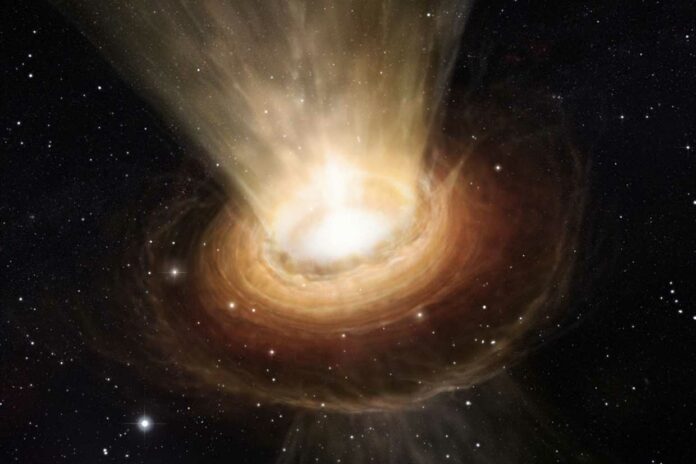Planetary systems like our solar system contain more rocky objects than gas-rich ones. Around our sun, these include the inner planets – Mercury, Venus, Earth, and Mars – the asteroid belt, and the Kuiper belt objects such as Pluto.
However, most material is found in Jupiter, Saturn, Uranus, and Neptune gas. As scientists have long known, planet-forming disks begin with 100 times more gas than solids. This raises an important question: How and when does most gas exit a developing planetary system?
A new study led by Naman Bajaj at the University of Arizona Lunar and Planetary Laboratory provides answers. Using the James Webb Space Telescope, or JWST, the team obtained images from a nascent planetary system—also known as a circumstellar disk—in the process of actively dispersing its gas into surrounding space.
The gas dispersion offers a better idea of how much time gaseous planets have to consume the gas from their surroundings. JWST provides previously unobtainable views into these disks around young stars, which are the planets’ birthplaces, assisting in our understanding of how planets develop.
Planets form as small particles within a spinning disk of gas and dust around a young star. Planetesimals are larger particles made up of these particles that cling to one another. Planets are formed when these planetesimals collide with one another throughout time. The amount of material available and how long it remains in the disk determine the planets’ kind, size, and final location.
“So, in short, the outcome of planet formation depends on the evolution and dispersal of the disk,” Bajaj explained.
A significant finding in this study is about T Cha, a young star surrounded by a fading disk with a substantial gap in dust about 30 times the distance from Earth to the sun. Bajaj and his team captured images of the gas leaving the disk for the first time.
They used a telescope sensitive to light atoms emitting when they lost electrons due to high-energy radiation like starlight. This light, known as ionization, is a chemical signature. In the case of the T Cha system, they traced two noble gases, neon and argon. The observations also revealed the first detection of double ionization of argon in a disk where planets are forming, as noted by the team in their paper.
“The neon signature in our images tells us that the disk wind is coming from an extended region away from the disk,” Bajaj said. “These winds could be driven either by high-energy photons – essentially the light streaming from the star – or by the magnetic field that weaves through the planet-forming disk.”
Another group, under the direction of Andrew Sellek from Leiden University, used computer simulations to get greater insight into the gas distribution around newborn stars. They imitated the dispersal of gas due to the intense light coming from the newborn star, known as stellar photons. They discovered that the dispersal brought on by these high-energy photons may account for what they observed by comparing their models with the actual facts. Additionally, they found that the moon’s mass on Earth is roughly equal to the annual outflow of gas from the T Cha disk.
Neon signs were found in numerous other space objects before this study, but it wasn’t until 2007 that researchers realized these signatures originated from small disks where planets are forming. LPL professor Ilaria Pascucci initially detected these neon signs using NASA’s Spitzer Space Telescope. They were an indication of gas winds emanating from these disks, she concluded. This finding changed how scientists examine the gas distribution surrounding newborn stars.
Pascucci said, “Our discovery of spatially resolved neon emission – and the first detection of double ionized argon – using the James Webb Space Telescope could become the next step towards transforming our understanding of how gas clears out of a planet-forming disk. These insights will help us better understand the history and impact on our solar system.”
The team also discovered the evolution of T Cha’s inner disk on very short timescales, such as decades. They discovered that the JWST-observed spectrum is different from the Spitzer-detected spectrum previously.
According to Chengyan Xie, a second-year doctoral student at LPL who leads this in-progress work, this mismatch could be explained by a small, asymmetric disk inside of T Cha that has lost some of its mass in the short 17 years that have elapsed between the two observations.
“Along with the other studies, this also hints that the disk of T Cha is at the end of its evolution,” Xie said. “We might witness the dispersal of all the dust mass in T Cha’s inner disk within our lifetime.”
Journal Reference:
- Naman Bajaj, Ilaria Pascucci et al. JWST MIRI MRS Observations of T Cha: Discovery of a Spatially Resolved Disk Wind. The Astronomical Journal. DOI 10.3847/1538-3881/ad22e1
